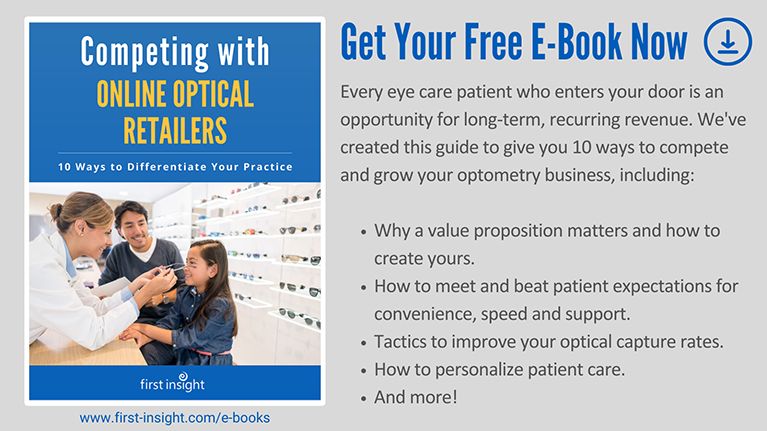
14 May 11 Steps to Motivate and Empower Your Eye Care Staff
Delivering exceptional eye care services requires a blend of expertise, efficiency, and empathetic communication. Your staff is the backbone of your practice. If your team isn’t happy and motivated, your practice will not progress.
Managing a multigenerational workforce is challenging for optometry and ophthalmology practices. These 11 strategies will help improve staff performance and retention.
1. Actively solicit ideas from staff on potential inefficiencies.
The Vision Council’s Provider inSights research report shows that “hiring remains the biggest challenge for eye care providers.” According to the Grammarly 2024 State of Business Communication report, the average employee spends “88% of their workweek communicating.”
If you and your staff don’t have regular meetings, make it a goal to start this important communication routine. Weekly meetings are a great time to consult staff on potential inefficiencies. Regular meetings help solve the practice’s ongoing issues, such as marketing, customer service, check-in processes, inventory management, improving optical capture rate, and billing procedures.
Front-line staff may also have unique practice management solutions and ideas for attracting new patients and retaining existing patients.
2. Encourage growth through continuing education.
Thinking regularly about your staff’s growth and opportunities will help retain dedicated, talented employees. Every eye care practice is busy, but allowing time for continuing education is important to keep up with the latest techniques, research, and technologies.
- Actively encourage your staff to keep their knowledge fresh by offering continuing education opportunities, such as paid workshops on new technologies, conferences, and tradeshows where they can connect with eye care experts.
- Consider contributing to optical society memberships or certification renewals.
- Invite a guest speaker to your practice to focus on professional and personal growth.
3. Clarify the chain of command.
Confusion or breakdown in the chain of command can cause problems in any business. At the earliest opportunity, clarify the positions in your office and ensure your staff feels their current title reflects their roles and responsibilities.
Establishing clear lines of communication prevents misunderstandings, reduces conflicts, and promotes a more productive and efficient work environment.
Don’t ignore any problems; instead, deal with issues head-on, no matter how small they seem. Problems will not disappear magically, and they can turn into distractions. Your staff will appreciate that you care and respect you for taking the lead in offering solutions.
4. Improve your insurance and vision plan billing rejection and denial rate.
Approximately 25% of lost practice revenue comes from poor billing and revenue cycle management (RCM) practices. Researching denied or unpaid claims makes accounts receivable a real chore for staff. It’s easy to input duplicate claims, transpose Medicare Beneficiary Identifier (MBI) numbers, and use incorrect diagnosis or procedure codes.
Consider investing in optometric billing and RCM services like Fast Pay Health by First Insight. When your staff constantly manages insurance and vision plan billing tasks daily, like outstanding claims, denied claims management, insurance verification and eligibility, and more, issues start to compound.
Related: 10 Reasons You Need an Optometric Billing and RCM Service
In addition, eye care practice management and EHR software like MaximEyes.com’s all-in-one solution allows you to sync information between the scheduling and billing departments, leading to fewer mistakes.
5. Provide your staff with discounted eyewear and complimentary exams.
Complimentary eye exams and discounted eyewear are great benefits for your staff. Your staff will appreciate the value of regular eye exams and the ensuing health benefits.
This perk will give staff a personal experience to share with your patients and increase their confidence in your services and eyewear products.
6. Improve engagement with patient portals and patient engagement tools.
Using practice management and EHR software that offers a built-in patient portal and patient engagement tools is a great way to improve patient engagement and empower your staff to perform more efficiently.
Patient Intake Forms: Is your staff spending too much time re-entering patient information from paper to computer at check-in? It’s time to create a positive experience for your office and patients, moving from paper forms on clipboards to digital patient intake forms.
Online Bill Pay: Your patients will appreciate the convenience of paying bills from home or on mobile devices. Your staff can reallocate these hours to higher priorities. For example:
- Online bill payments decrease time spent tracking payments, mailing out invoices, collecting funds over the phone, and manually posting payments.
- Send secure text (SMS) and email messages that remind patients of bills due.
7. Add reputation management tools that integrate with your eye care practice management software.
Using built-in reputation management tools with your eye care software will help relieve stress from another task on your list. Without automated reputation management, you must manually send your patients surveys and reminders to complete a review after their visit.
In MaximEyes.com, create settings to automatically send your patient an SMS or email to complete a survey based on their experience. In addition, send automatic reminders if your patient has not completed the survey in a few days.
With the right reputation management tools and strategies, you can ensure that your brand is presented to potential and current patients in the best possible light.
8. Evaluate and track office productivity levels.
Put some time into evaluating your office efficiencies and productivity levels. This will ensure you hire and schedule the correct ratio of office management, front office, technicians, opticians, scribes, and medical staff. That way, everyone feels motivated and supported instead of tired and overworked.
9. Add a specialty to your practice to help retain patients.
Retaining patients is easier if you’re able to offer more options for specialized care. Consider the demographics of your area, then reach out to a specialist with experience in a field such as specialty contact lenses or dry eye conditions.
By offering more eye care services in-house, your staff will not have to refer people to other providers. Instead, you can innovate and grow your eye care practice.
10. Update office equipment, ophthalmic tools, and EHR software.
A common frustration among eye care staff is when management refuses to modernize. Updating technology and investing in training may seem costly, but ensuring patients receive the best care possible is worth it.
- Invest in updated technology, such as handheld instruments, digital refraction systems, and image management systems.
- Move your practice management and EHR system to the cloud. Updating and optimizing your EHR system will improve patient care and show your staff that you’re serious about giving them the tools they need to do excellent work.
For instance, MaximEyes.com’s all-in-one eye care EHR and practice management, engagement, and optical point-of-sale software tackle your frustrations by reducing the hurdles, ensuring a smooth transition and a reliable, user-friendly experience.
The built-in Learning Center within MaximEyes.com makes the learning experience easy and engaging. The visual aids, images, and examples make even the most complex workflows easy to grasp.
Related: Why MaximEyes.com is the Easiest Optometry Software to Use and Learn
11. Express appreciation to your staff with constant communication.
As with any team, it’s easiest to motivate staff when they know their needs are being considered. If you don’t know how to express appreciation, ask them directly. Motivated eye care staff are the key to an efficient, functional practice of caring for every patient.
One effective way is to offer positive feedback for good work. When your staff accomplish tasks or meet goals, let them know how much you appreciate their efforts.
By taking these steps, you can create a positive work environment where everyone feels appreciated, motivated, and eager to provide your patients with the highest care.





